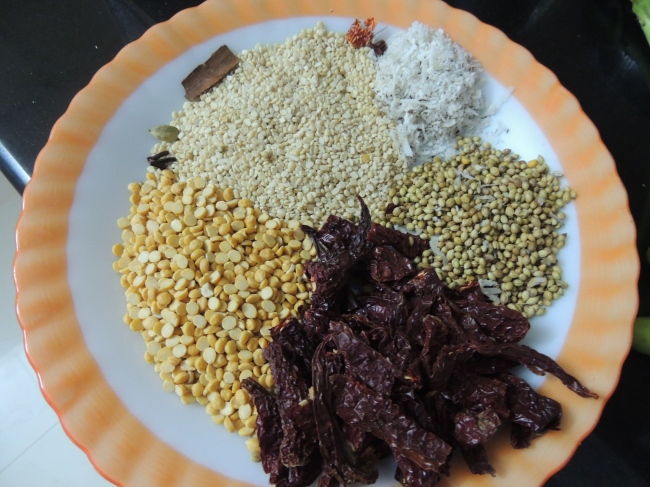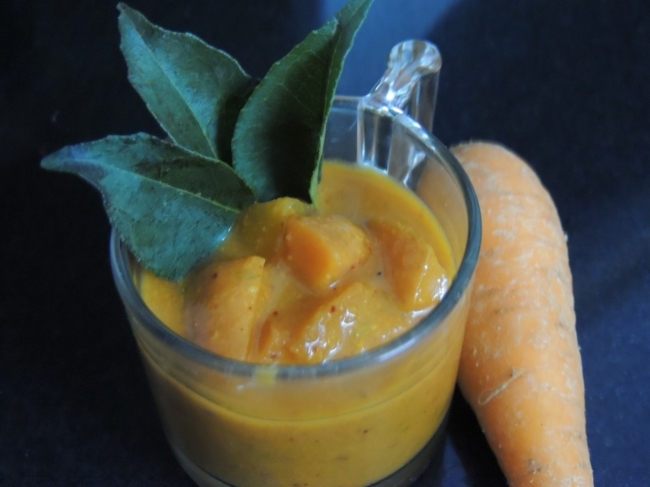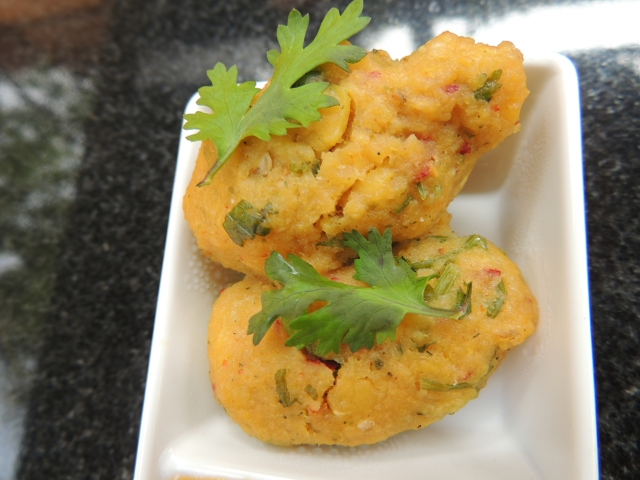At home we make different kinds of Gojju! It’s a tangy, sweetish gravy dish which can be eaten with steaming hot rice and rotis as well. Decided to make this day into a day for experimenting. So took out whatever veggies I had at home and decided to try out Gojju with carrots and apples. Will post the Apple Gojju later. First of all, wanted to make fresh Gojju powder.
Ingredients
For Gojju Powder
1. 1/2 cup Channa Dal
2. 1/2 cup Urad Dal
3. 1/4 Coriander seeds
4. 1 1/2 cups of Dried Red Chilli (I used Bydagi as this gives an awesome red colour and is not the spicy. Kashmiri Chilli is also fine)
5. 3 Cloves
6. 1″ Cinnamon stick
7. 1 pod of Green Cardamom
8. 6 – 8 seeds of Methi seeds
9. 3 tsps of grated desiccated coconut (Ona Kobbari)
10. 6 – 8 curry leaves
For the Gojju
11. 2 tbsp grated Jaggery
12. 2 – 3 tsp of Tamarind Paste
13. 1 tsp fresh grated Coconut
14. 3 Carrots diced
For the tempering
15. 1 tsp ground nut oil (You can use any oil. But the flavour of Ground nut oil is awesome)
16. 1/4 tsp mustard seeds
17. 1/4 tsp turmeric powder
18. a pinch of asafoetida (Hing)
19. 4 curry leaves
Method
For the Gojju Powder

1. Dry roast the dals together until they turn golden brown

3. Dry roast Corianders seeds, red chillies, methi seeds, cinnamon, cloves, cardamom and curry leaves. Roast till the coriander seeds start sputtering. Do not over roast as the chillies will darken and the look of the curry will turn brown.
 4. Warm the desiccated coconut. Cool all the ingredients and store in an air tight jar. This can be used to make other gojjus as well.
4. Warm the desiccated coconut. Cool all the ingredients and store in an air tight jar. This can be used to make other gojjus as well.
For the Carrot Gojju
1. Dice the carrots into cubes
2. Heat the oil in a kadhai or a wok. Add the mustard seeds. Once they start sputtering add the hing and curry leaves and turmeric powder.
3. Saute for a few seconds and add the diced carrots. Cook on medium flame covered. This retains all the nutrients of the vegetable.
4. Once the carrots are soft add the tamarind paste, jaggery powder, salt to taste and 2 cups of water and let it simmer.
5. Meanwhile, take 2 to 3 tsps of the gojju powder and the grated coconut and grind into a smooth paste.
6. Add this paste to the simmering water and bring to boil. Check on the seasoning and adjust according to taste. We usually prefer both sweet and tangy to be on the higher side.
7. Garnish with chopped coriander leaves and serve hot with rice or rotis.

 These naturally sweet and crunchy vegetable is a healthy addition to our diet. They are rich in beta-carotene, vitamin A and anti-oxidants. No matter how you eat this vegetable, it is rich in nutrition. Though studies have shown that cooked carrots contain more anti-oxidants than the raw carrots. This is because cooking releases the anti-oxidants. There are so many websites which give you info about carrots do look into it.
These naturally sweet and crunchy vegetable is a healthy addition to our diet. They are rich in beta-carotene, vitamin A and anti-oxidants. No matter how you eat this vegetable, it is rich in nutrition. Though studies have shown that cooked carrots contain more anti-oxidants than the raw carrots. This is because cooking releases the anti-oxidants. There are so many websites which give you info about carrots do look into it.
We’ve always been told that carrots are great for our eyes. I saw a post recently on FB which shows that when looked closely, a chopped carrot resembles the cornea!! That was a very interesting post.















